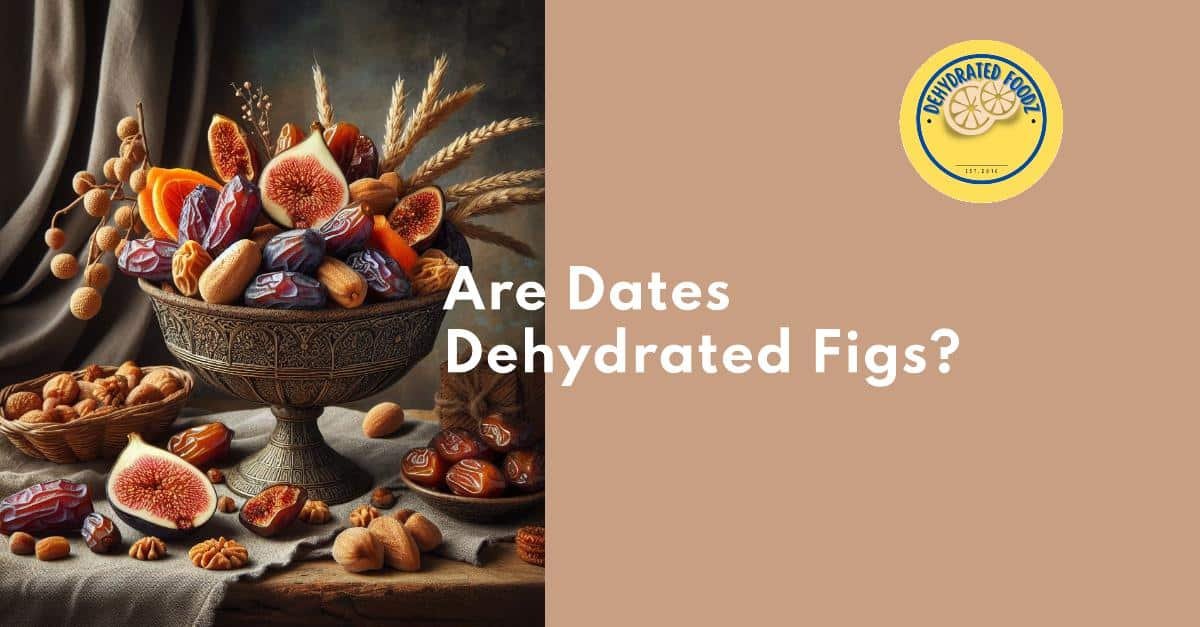Unlock the full potential of your dehydrator with The Ultimate Guide to Dehydrator Recipes! This comprehensive ebook is your go-to resource for crafting delicious, healthy, and long-lasting snacks and meals. Perfect for beginners and experienced dehydrating enthusiasts alike, this guide provides everything you need to know to boost your kitchen game.

Are Dates Dehydrated Figs? Unveiling The Truth
The world of dried fruits is riddled with misconceptions and food myths, especially when it comes to understanding the origins and differences between certain types. A pervasive question for many is “Are dates dehydrated figs?” This article aims to dissect this common conundrum with an analytical lens, providing a clear differentiation between the two while addressing the myths surrounding them.
Introduction
When it comes to sweet, chewy treats that double as nutritional powerhouses, dates, and dehydrated figs are popular choices. However, the notion that dates are merely dehydrated figs is a mix-up that we often encounter. It’s time to set the facts straight and clarify what sets these two fruits apart from one another.
Are Dates Dehydrated Figs?
It’s essential to recognize that dates and dehydrated figs are not the same fruit, nor are they different stages of the same produce. Dates are the fruits of the date palm tree (Phoenix dactylifera), whereas dehydrated figs originate from the fig tree (Ficus carica). These fruits possess unique properties—textural nuances, moisture content, and subtle flavor differences—that make them stand out.
Contrasting Characteristics
Visually, dates usually have a wrinkled skin, while dehydrated figs might exhibit a somewhat smoother texture. Dates are oblong and often have a shiny finish, compared to the rounder, less glossy dehydrated figs. The taste profile differs markedly as well—dates offer a rich sweetness that has hints of caramel, while figs present a milder, nutty flavor profile.
Nutritional Differences
The nutritional makeup of dates and dehydrated figs further underscores their distinct identities. While dates boast a higher caloric and natural sugar content, dehydrated figs offer greater amounts of fiber and calcium, making each fruit uniquely beneficial.
Color Variation Between Dates and Dehydrated Figs
The visually discernible differences between dates and dehydrated figs extend into their coloration, a fundamental aspect that contributes to their distinct identities. Typically, dates exhibit a range from light amber to deep, rich brown, influenced by both the variety and the maturity stage at the time of harvest. In contrast, dehydrated figs predominantly display a hue that varies from pale yellow to a darker purple-brown, depending on the specific type of fig and the process of dehydration it undergoes. This variation in color not only aids in their identification but also reflects the diversity of their respective nutritional contents and flavor profiles, further cementing the identity of each fruit within the broad spectrum of dried fruits.
Dissecting the Flavor Profiles
In the realm of dried fruits, the distinction between the taste of dates and dehydrated figs is significant and deserving of a detailed analysis. Dates are renowned for their intense sweetness, often likened to caramel or honey, with a dense, chewy texture that accentuates their rich flavor profile. This inherent sweetness makes them a favored ingredient in various desserts and sweet dishes, contributing natural sugars that enhance the culinary experience.
Conversely, dehydrated figs present a more nuanced taste, characterized by a subtle sweetness mingled with a hint of nuttiness, which can sometimes verge on savory. Their texture differs from that of dates, offering a slightly crunchier bite due to the seeds contained within, providing a unique sensory experience. This complexity of flavor makes dehydrated figs versatile in both sweet and savory dishes, adding depth and richness that complements a wide array of ingredients.
Understanding these taste dynamics is crucial for culinary enthusiasts and nutrition-conscious consumers alike, as it guides ingredient selection in creating balanced and flavorful dishes. The analytical juxtaposition of dates and dehydrated figs in terms of flavor not only highlights their distinct characteristics but also emphasizes the importance of choosing the right dried fruit to complement specific dishes, ultimately enriching the gastronomic landscape.
Culinary Uses and Benefits
While dates and dehydrated figs may occasionally be substituted for one another in recipes, their distinctive flavors and textures can alter the taste and consistency of a dish. Dates, with their sticky and moist nature, are often used to sweeten desserts or even as a binding ingredient. In contrast, dehydrated figs, which are a bit drier and chewier, can add a more nuanced, mellow sweetness to recipes.
Distinct Flavors and Textures in Recipes
One cannot simply swap dates for dehydrated figs in a recipe without expecting a change in the gastronomical outcome. It’s the unique textures and sweetness levels that contribute to each dried fruit’s culinary versatility, hence, careful consideration should be applied when using them in your cooking endeavors.
Health Benefits
Both dates and dehydrated figs bring a wealth of health benefits to the table. Dates serve as excellent energy boosters and are advantageous for those in need of a high-energy diet due to their higher carbohydrate content. On the other hand, dehydrated figs are a wise choice for individuals looking to increase their dietary fiber intake for improved digestive health.
Conclusion
It’s imperative to acknowledge that dates are not dehydrated figs. Each dried fruit demands its own recognition for its distinctive characteristics, nutritional values, and the distinct culinary roles it plays. By understanding the differences, consumers can make informed decisions aligned with their dietary preferences or culinary requirements.
The dialogue about these fruits reflects a broader conversation on how we approach food knowledge and nutrition. Dispelling myths and providing accurate information aids everyone in making choices that are both healthful and delicious. We encourage you to continue exploring the diversity of nature’s offerings with the same analytical and objective eye.


